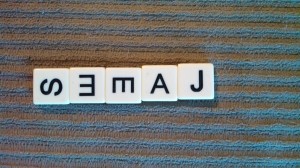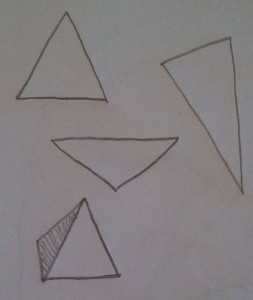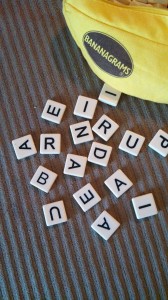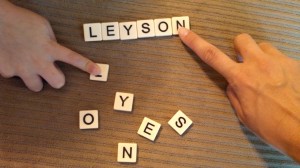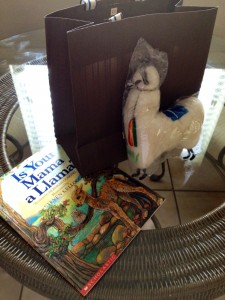“Look, Mom! I spelled ‘James!'”
I have had many parents come to me worried that their preschool or kindergarten aged child may be dyslexic* after he or she continues to spell and write words/letters backwards, upside down, in mirror image, or mix up letters within a word.
Let me say now that this writing behavior is totally normal at this stage in your child’s pre-writing and pre-reading development and in most cases* is not indicative of a learning disability.
Let’s think about this…
We, the smarter-than-the-average-preschooler mommy teachers, see a triangle. 3 sides + 3 points = triangle no matter how you look at it.
(Technically that last one is a pyramid says my 5year old, but you get my point.)
What, then, is the letter A?
It is but a mere visual representation of a sound in a word… a symbol… or simply, a shape, not unlike our friend, the triangle. We recognize this shape no matter the direction, font, size or color. Our brains are hardwired to group these similar shapes together so we can recognize them even though they may look slightly different than the Times New Roman capital letter A.
Our kids are naturally doing the same exact thing which is why they can still find the letter A in a pile of letters, even though some of the As are upside down.
To help teach correct directionality (the direction in which we read and write in English), use your index finger to guide reading: top-bottom, left-right. This is a learned skill and will become ingrained through repetition and practice. In Leyson’s case, if he knew that he should have spelled the letters out from left to right, the word would have actually spelled JAMES instead of SEMAJ – but with a sideways S and an E for an M… babysteps.
When Leyson spelled James’ name backwards, I then modeled how to spell his own name as he said the letters out loud to me. Leaving those letters in place, I then pulled a second set of letters for his name and asked him to put them in order directly under the one I had done.
“Which letter comes first? Which comes second?” Etc.
To fix his sideways S, I lined up a few of the same letter and laid them out right side, upside down and sideways and we chose the correct letter. This taught him that it DOES matter which way a letter is written… BAM! Epiphany.
Back to his spelling of James’ name:
Me: “Now, if we spelled the name LEYSON with the L over here on the left, what is different about how you spelled JAMES?”
Leyson: “I used an upside down E as an M!”
Epiphany x2.
* Dyslexia is a Developmental Reading Disorder (DRD) which is one of the most common learning disabilities. A small percentage of those with this type of DRD actually see and write letters backwards or upside down. Most often dyslexia is diagnosed within the critical beginning reader years (kindergarten – 2nd grade) if a child of normal intelligence still has difficulties with visual and/or auditory reading comprehension, spelling and phonological awareness.
If after age appropriate and developmentally appropriate reading and writing strategies have been correctly taught to your school-aged child and you find he or she is still struggling with reading, begin to log your perception of your child’s reading abilities and share it with your child’s teacher or doctor so they can determine if your child may need further evaluation.

